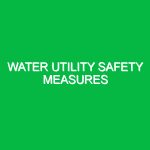The intricate world of gas utility operations is a crucial component of modern infrastructure. Gas utility operations and safety encompass the processes involved in the distribution, management, and maintenance of natural gas, ensuring that energy reaches homes and businesses safely and efficiently. Given the potential hazards associated with gas utilities, including explosions, leaks, and environmental impacts, the relevance of Health, Safety, and Environment (HSE) practices cannot be overstated. This article delves into the complexities of gas utility operations, highlighting key safety measures, risks, and regulatory frameworks that govern this essential industry.
Understanding Gas Utility Operations
Gas utility operations refer to the systems and processes that manage the production and distribution of natural gas. This includes everything from extraction and treatment to transportation through pipelines and eventual delivery to consumers. The operations are multifaceted, involving various technologies and personnel trained to handle the intricacies of gas management.
At its core, gas utility operations aim to provide a reliable energy source while minimizing risks associated with gas production and distribution. Safety measures are integral to these operations, as they directly relate to public safety, environmental protection, and regulatory compliance. In an industry where the stakes are high, the implementation of robust safety protocols is essential.
Potential Hazards and Risks in Gas Utility Operations
Gas utility operations are not without their dangers. Understanding these risks is the first step in mitigating them. Key hazards include:
1. Gas Leaks
Gas leaks pose one of the most significant risks in the industry. A leak can occur due to pipeline corrosion, faulty equipment, or human error. The presence of gas in the air can lead to explosions and fires, impacting both personnel and the surrounding community.
2. Explosions
Explosions can result from the ignition of accumulated gas. These incidents can cause catastrophic damage to infrastructure, injuries to workers, and even loss of life. It is crucial to understand the factors that contribute to such explosive events, including pressure imbalances and ignition sources.
3. Environmental Impact
Gas utility operations can have environmental ramifications. Methane emissions, for example, contribute to climate change, while spills can contaminate soil and water supplies. Understanding these impacts is vital for developing sustainable practices within the industry.
4. Equipment Failures
Failures in equipment, such as valves, compressors, or pipelines, can lead to significant safety issues. Routine maintenance and monitoring are necessary to ensure all components function correctly and to prevent accidents.
5. Human Factors
Human error remains a leading cause of accidents in gas utility operations. Inadequate training, poor communication, and lack of awareness can all lead to hazardous situations. Addressing these human factors is essential for enhancing safety protocols.
Safety Precautions and Best Practices
To combat the risks associated with gas utility operations, implementing safety precautions and best practices is crucial. Here are several actionable strategies:
1. Regular Training and Drills
Continuous training for employees on safety protocols helps to reinforce best practices. Regular drills simulating emergency situations can prepare staff to respond calmly and effectively in crisis scenarios. For instance, a gas utility company in Texas conducts quarterly emergency response drills, which have significantly improved employee readiness and reduced response times during actual incidents.
2. Comprehensive Inspections and Maintenance
Routine inspections of pipelines, valves, and other equipment are essential for identifying potential issues before they escalate. Implementing a proactive maintenance schedule can help prevent failures and extend the lifespan of critical infrastructure. Companies should also employ advanced technologies, such as drones or smart sensors, to monitor hard-to-reach areas of pipelines.
3. Leak Detection Systems
Investing in advanced leak detection technologies can mitigate the risks associated with gas leaks. Systems that use acoustic sensors, infrared cameras, or gas chromatography can identify leaks quickly, allowing for timely intervention. Implementing these technologies has proven effective for many gas utilities, reducing leak-response times by up to 50% in some cases.
4. Emergency Response Plans
Developing and regularly updating emergency response plans ensures preparedness for gas-related incidents. These plans should include clear procedures for evacuating affected areas, communicating with emergency services, and informing the public. An example is the response plan initiated by Columbia Gas in Massachusetts, which helped coordinate efforts during a series of explosions in 2018, allowing for an efficient response despite the chaos.
5. Community Engagement
Fostering relationships with the community can enhance safety. Utility companies should engage with residents through informational sessions, providing education on gas safety and emergency procedures. This proactive approach can empower communities to act effectively in case of a gas-related emergency.
Regulatory Standards Governing Gas Utility Operations
Gas utility operations are subject to a range of regulations designed to ensure safety and environmental protection. Key regulatory bodies include the U.S. Department of Transportation’s Pipeline and Hazardous Materials Safety Administration (PHMSA) and the Occupational Safety and Health Administration (OSHA). These organizations establish standards that govern everything from pipeline integrity management to employee safety training.
In the United States, regulations such as the Natural Gas Pipeline Safety Act enforce compliance with safety standards and require regular inspections. Similarly, the Clean Air Act mandates that gas utilities minimize emissions, contributing to environmental protection efforts. Understanding and adhering to these regulations is vital for gas utility companies to maintain operational safety and avoid legal repercussions.
Conclusion: A Commitment to Safety in Gas Utility Operations
In conclusion, gas utility operations represent a vital aspect of modern energy distribution, but they come with inherent risks that require vigilant attention to safety practices. By understanding potential hazards, implementing best practices, and adhering to regulatory standards, gas utility companies can enhance their safety culture and protect both their employees and the communities they serve. The importance of a proactive approach to health, safety, and environmental concerns cannot be overstated. As the industry evolves, so too must the commitment to safety, ensuring a reliable and secure energy future.


